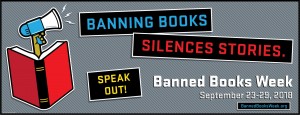Recently on nomansland.blog, writer Lavender Vroman took a look at “What happens when someone comes for your comics, Neil Gaiman, and Harry Potter?” Most nerds would think the only way someone is prying those three away from them, is out of their carbonite frozen hands – but as Vroman demonstrates, these books (and many others) are challenged and banned more frequently than people think.
Vroman walks the reader through book challenges and bans, beginning with an interview with Banned Books Week Coordinator, Betsy Gomez, who designed and edited the new Banned Books Week Handbook. Gomez told Vroman, “Books are vessels for ideas, and sometimes people are uncomfortable with or don’t agree with those ideas, so they challenge others’ access to them.”
Vroman writes,
“Gomez said the American Library Association’s Office for Intellectual Freedom ‘tracks hundreds of challenges and bans each year, and the actual number is probably much larger because censorship is underreported. Most libraries and schools have challenge policies, and most challenges fail. But challenges that happen in a vacuum — when people and free speech advocates don’t find out about them — more often result in a ban.”
Vroman also spoke with Comic Book Legal Defense Fund’s Executive Director, Charles Brownstein, about CBLDF’s role in challenges. After going through the vivid history of banning comics in the U.S., the conversation moved up to the current state of challenges in the country. Brownstein told Vroman, “These days we see that materials regarding LGBTQ+ issues are getting challenged most frequently, followed by work addressing sexuality more generally. And let me be clear, we’re talking about mainstream, often award-winning material.”
CBLDF supporters know that one of the most contested books out there right now is Drama by Raina Telgemeir, a YA graphic novel that faces the firing squad so frequently because of a chaste, same-sex kiss between two male characters. This book has repeatedly been on the ALA’s Top Ten Most Challenged and Banned Books list. Just last year, out of all the books challenged in the state of Texas, Drama was the only one banned – and it was banned twice that year in two different school districts. So what happens once the challenge is made?
Vroman continues,
“When the CBLDF learns of such cases, the organization responds by providing ‘guidance and counseling behind the scenes, often connecting the affected librarian or teacher with resources to help defend the challenge,’ Brownstein said. The group also provides letters of support ‘privately and publicly,’ sometimes in partnership with coalitions such as the Kids’ Right to Read Project. ‘We also create a great deal of preventative resources, including discussion guides, case studies, and presentations to help people better understand the value of graphic novels, the importance of intellectual freedom, and how to protect them both,’ Brownstein said.”
Elementary School Librarian Fawn Kemble was able to talk about these resources and support first hand with Vroman after a challenge to The Dragonslayer, the fourth volume of Jeff Smith’s series Bone, left her concerned the comic would be removed from her library for good.
The challenge in Kemble’s case came from a colleague over a character that shown drinking, smoking, and hanging out in a pub gambling. “[Kemble] tried to explain to (the aid) the context of the stories, how this character is not glorified nor romanticized, and how valuable this series is for the kids to read, but she wouldn’t budge.”
After reaching out to CBLDF on Twitter, she was able to get support and resources for a crucial meeting over the fate of the book with her vice-principle.
“I was very happy with the way this particular situation worked out. The resources sent to me by the CBLDF, as well as the case study they had posted on their site, helped me go into my meeting calm, confident, and prepared. Situations like these don’t always work out well.”
One of the most illuminating parts of Vroman’s article discusses one of the less frequently addressed part of the book challenging process – the challenger.
“Kemble said she tries to give the parents or colleagues in these situations the benefit of the doubt.
‘Even though I passionately love books and believe the children should have access to many of those which are commonly banned, I try to start by reminding myself that the parent or staff member is just trying to protect their child or student. They mean well, so I always listen to their concerns with respect.”
These statements are echoed from within the community of that fight for freedom of expression. Gomez told Vroman, “Books are usually challenged with the best of intentions, often motivated by a desire to protect young readers from ‘inappropriate’ content. But these people are ultimately trying to take away other readers’ power to decide what books are right for themselves or their children.”
Brownstein remarked, “People generally don’t think of their calls to remove something as censorship. But it is. … The best solution to these problems is open-mindedness and dialogue. Consider why someone else may value what you don’t and let them make up their own mind. And if you don’t like it, nobody is making you do so! There’s a universe of great material in the library for everybody!”
To find out more about the behind the scenes of bans and challenges, read the full piece here
